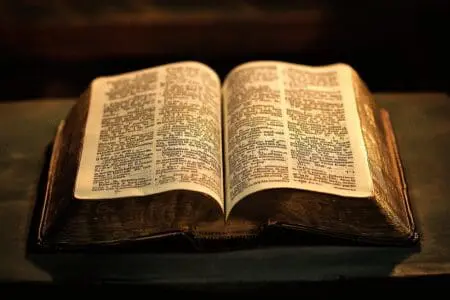Ever picked up a Bible and just felt… lost? It’s a huge book. Or, more accurately, it’s a whole library of books bound together. If you’re trying to figure out where to even start, a simple, practical question often comes up first: “How many chapters are in each book of the Bible?” It’s the kind of question you might ask before starting a new reading plan, to settle a friendly debate, or just out of pure curiosity about this ancient collection of texts.
That question takes me straight back to my childhood. My grandma had this old King James Bible, the kind with a worn leather cover and pages so thin you could almost see through them. I remember tracing my finger down the columns, trying to count all the chapters. I never made it. I’d always get hopelessly lost somewhere in the middle of Psalms. That curiosity stuck with me, though. It grew into a real appreciation for how this incredible library is structured. Knowing the chapter counts is like getting a map before a road trip—it shows you the lay of the land.
More in Bible Category
What Is the First Word in the Bible
When Was the Ethiopian Bible Written
Key Takeaways
Before we jump into the full breakdown, here are the big-picture numbers to keep in mind:
- Total Chapters: The Protestant Bible has a whopping 1,189 chapters.
- Old Testament: This first section contains 929 chapters across 39 different books.
- New Testament: The second section is shorter, with 260 chapters across 27 books.
- A Human Touch: Remember, the chapter and verse numbers weren’t in the original scrolls. They were added much, much later by scholars to make finding passages easier for everyone.
Why Even Bother Counting the Chapters?
So, what’s the big deal with counting chapters? Is it just for trivia night?
Not at all. Knowing the basic layout of the Bible actually makes it way less intimidating. When you see it as an anthology of different works—histories, poems, letters, prophecies—instead of one giant, scary book, it becomes approachable.
Realizing that 3 John is just a single chapter while Psalms has 150 gives you a sense of scale. It lets you set goals you can actually achieve. Reading the book of Jude is a quick afternoon read. Tackling the book of Jeremiah is a serious commitment.
On top of that, it gives you context. When you know how big a book is and where it sits in the grand story, you get a better feel for its message. It’s the difference between staring at a single tree and seeing its place in the whole forest. This simple knowledge can be the first step to a much richer reading experience. It makes a daunting task feel doable.
So, How Were the Chapters and Verses Decided Anyway?
Here’s a fun fact that throws a lot of people for a loop: the Bible wasn’t originally written with chapters and verses. The authors wrote on scrolls, often in long, flowing blocks of text without any breaks. Can you imagine trying to reference a specific spot? You’d have to say something like, “Look for the part in Isaiah about halfway down the scroll, just after that story about the vineyard.”
It was a messy system, to say the least.
Things got much easier around 1227 A.D. thanks to a professor named Stephen Langton, who would later become the Archbishop of Canterbury. He broke the Latin Vulgate Bible into chapters to help his students find their way around the text. His idea was so brilliant and useful that it caught on everywhere.
Then, in the 1550s, a French printer by the name of Robert Estienne finished the job. He was the one who added the verse numbers we use today. The story goes that he did most of this work while riding on horseback. That might explain why some verse breaks feel a little random—it’s hard to be precise on a bumpy road! These divisions aren’t sacred, but they are incredibly practical tools for study and discussion.
The Old Testament: A Complete Chapter Breakdown
The Old Testament is where the whole story begins. It’s the bigger, older part of the Bible, an epic that stretches from the dawn of creation to the promises of prophets. It’s usually broken up into four main parts: the Pentateuch, the Historical books, the Wisdom books, and the Prophets.
The Books of Moses (The Pentateuch)
These first five books, also known as the Torah, set the stage for everything that follows. They tell the foundational story of creation, the patriarchs, and the birth of the nation of Israel.
- Genesis: 50 Chapters
- Exodus: 40 Chapters
- Leviticus: 27 Chapters
- Numbers: 36 Chapters
- Deuteronomy: 34 Chapters
What About the Historical Books?
This is where the action picks up. These books cover hundreds of years of Israel’s history—from conquering the promised land to the glory days of the kingdom, its tragic division, and the exile of its people. They are packed with incredible stories.
- Joshua: 24 Chapters
- Judges: 21 Chapters
- Ruth: 4 Chapters
- 1 Samuel: 31 Chapters
- 2 Samuel: 24 Chapters
- 1 Kings: 22 Chapters
- 2 Kings: 25 Chapters
- 1 Chronicles: 29 Chapters
- 2 Chronicles: 36 Chapters
- Ezra: 10 Chapters
- Nehemiah: 13 Chapters
- Esther: 10 Chapters
Are the Wisdom and Poetry Books Structured Differently?
They sure are. This section is less about history and more about the human experience. It’s full of beautiful poetry and deep reflections on life’s biggest questions—things like suffering, love, wisdom, and purpose.
- Job: 42 Chapters
- Psalms: 150 Chapters
- Proverbs: 31 Chapters
- Ecclesiastes: 12 Chapters
- Song of Solomon (or Song of Songs): 8 Chapters
The book of Psalms is unique. Its 150 chapters are actually 150 individual songs or poems, making it the longest book in the Bible by a landslide.
And the Major Prophets?
The prophets were God’s spokespeople. They called Israel to be faithful and just, and they warned about what would happen if the people strayed. We call them “major” prophets simply because their books are longer, not because they were more important.
- Isaiah: 66 Chapters
- Jeremiah: 52 Chapters
- Lamentations: 5 Chapters
- Ezekiel: 48 Chapters
- Daniel: 12 Chapters
Don’t Forget the Minor Prophets!
Their books may be short, but the “minor” prophets deliver some heavy-hitting messages. In just a few chapters, they tackle everything from social injustice to God’s incredible mercy.
- Hosea: 14 Chapters
- Joel: 3 Chapters
- Amos: 9 Chapters
- Obadiah: 1 Chapter
- Jonah: 4 Chapters
- Micah: 7 Chapters
- Nahum: 3 Chapters
- Habakkuk: 3 Chapters
- Zephaniah: 3 Chapters
- Haggai: 2 Chapters
- Zechariah: 14 Chapters
- Malachi: 4 Chapters
The New Testament: Your Guide to Every Chapter
Then we get to the New Testament. This is where the story pivots, focusing entirely on the life of Jesus and the birth of the early church. It’s much shorter than the Old Testament, but its impact on the world has been immense. We can group these 27 books into the Gospels, History, Letters, and Prophecy.
The Gospels and the Story of Jesus
These first four books are the heart of the New Testament. Each one paints a unique picture of Jesus’s life, teachings, death, and resurrection.
- Matthew: 28 Chapters
- Mark: 16 Chapters
- Luke: 24 Chapters
- John: 21 Chapters
What’s the Story with the Book of Acts?
Think of Acts as Part 2 of the Gospel of Luke, written by the same person. It tells the incredible story of what happened next—how a small group of disciples, empowered by the Holy Spirit, started a movement that spread across the Roman Empire.
- Acts: 28 Chapters
Breaking Down Paul’s Letters (Pauline Epistles)
A huge chunk of the New Testament is made up of letters from the Apostle Paul. He wrote to young churches and their leaders, teaching them about theology and encouraging them in their faith.
A few years ago, I led a study on the book of Philemon. Someone asked, “Why is this even in the Bible? It’s just one chapter and feels like we’re reading someone else’s mail.” It was a great question. We ended up having this amazing conversation about how the book’s power is in its small size. In one tiny letter, Paul gives a masterclass on forgiveness and reconciliation. It’s a perfect reminder that a book’s length has nothing to do with its importance.
Here are all of Paul’s letters:
- Romans: 16 Chapters
- 1 Corinthians: 16 Chapters
- 2 Corinthians: 13 Chapters
- Galatians: 6 Chapters
- Ephesians: 6 Chapters
- Philippians: 4 Chapters
- Colossians: 4 Chapters
- 1 Thessalonians: 5 Chapters
- 2 Thessalonians: 3 Chapters
- 1 Timothy: 6 Chapters
- 2 Timothy: 4 Chapters
- Titus: 3 Chapters
- Philemon: 1 Chapter
And the General Epistles?
These letters were written by other key leaders in the early church, like Peter, James, and John. They’re called “general” because they were written to a wider Christian audience, offering practical wisdom for everyday life.
- Hebrews: 13 Chapters
- James: 5 Chapters
- 1 Peter: 5 Chapters
- 2 Peter: 3 Chapters
- 1 John: 5 Chapters
- 2 John: 1 Chapter
- 3 John: 1 Chapter
- Jude: 1 Chapter
How Does It All End in Revelation?
The Bible’s grand finale is the book of Revelation. It’s a wild, symbolic, and deeply hopeful book of prophecy that looks ahead to the ultimate victory of good over evil and the renewal of all creation.
- Revelation: 22 Chapters
Are There Any Fun Facts About Bible Chapters?
Now for the fun stuff. Once you have the full list, you start to see some neat patterns and bits of trivia.
- The Longest and Shortest Books: The book with the most chapters is Psalms, with 150. The shortest books are Obadiah, Philemon, 2 John, and 3 John, which all have just one chapter.
- The Longest and Shortest Chapters: The longest single chapter in the Bible is Psalm 119, which has 176 verses. The shortest is Psalm 117, with a mere two verses.
- The Center of the Bible: In a cool twist, the shortest chapter, Psalm 117, is also the middle chapter of the entire Protestant Bible. There are 594 chapters before it and 594 chapters after it.
- Visualizing the Bible: If you’re a visual person, knowing the numbers is just step one. Checking out resources like The Bible Project can be a game-changer. They have amazing videos that illustrate the design and core message of every single book.
A Map for Your Journey
And that’s the full rundown. Every single one of the 1,189 chapters, laid out for you. It’s a lot to take in.
But here’s the most important thing to remember: this list isn’t the treasure. It’s the treasure map. These numbers and divisions are just tools, created centuries after the fact to help us find our way. They give us a framework and make this massive library feel a little more welcoming. The real adventure starts when you turn to page one, chapter one, and begin to read.
Frequently Asked Questions – How Many Chapters in Each Book of the Bible

How can knowing the number of chapters in each Bible book help me in my reading plans?
Knowing the chapter counts allows you to set realistic goals, such as reading a certain number of chapters or entire books within a specific timeframe. It helps you plan your reading, balance long and short books, and stay motivated while exploring the Bible.
Which book of the Bible has the most chapters, and which has the fewest?
The book with the most chapters is Psalms, with 150 chapters. The shortest books are Obadiah, Philemon, 2 John, 3 John, and Jude, each with only 1 chapter.
What is the total number of chapters in the New Testament, and how are those books organized?
The New Testament contains 27 books and a total of 260 chapters. These books are organized into sections such as the Gospels (Matthew, Mark, Luke, John), Acts, Pauline Epistles, General Epistles, and Revelation, grouped by their type of writing rather than chronological order.
How many chapters are in the books of the Old Testament’s Law (Pentateuch)?
The first five books of the Bible, known as the Pentateuch, have the following number of chapters: Genesis has 50, Exodus has 40, Leviticus has 27, Numbers has 36, and Deuteronomy has 34 chapters.
Why are chapters and verses added to the Bible, and how did this tradition start?
Chapters and verses were added to the Bible to make it easier to locate specific passages. The chapter divisions were introduced around 1227 AD by Stephen Langton, a professor and church leader, while verse numbers were added in the 1500s by French printer Robert Estienne. These additions were not part of the original texts but serve as helpful references.




